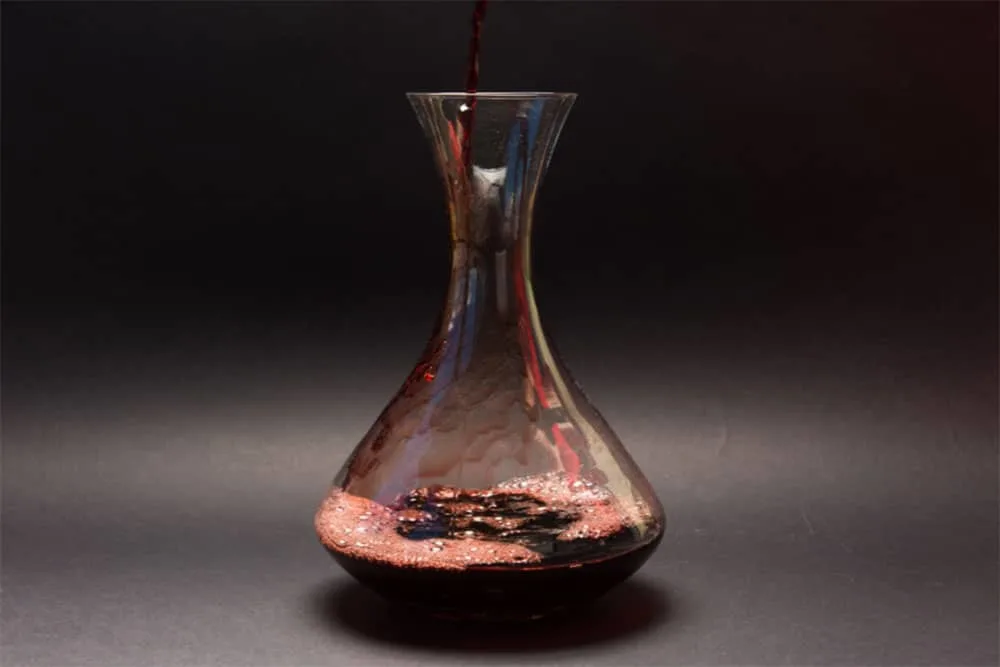Reading the tasting notes on a bottle of wine can confuse that first mouthful. Notes of plum? A lingering finish of blackberry? A hint of peppercorn?
None of that quite seems to be there. Instead, you find the flavors are mostly overwhelmed by a taste of alcohol, and a smell of sulfur.
This is where aeration comes in. When wine is exposed to air, the oxygen causes the initial sulfur and alcohol to evaporate and dissipate. With these less than pleasant flavors gone, you can actually identify the tasting notes the bottle so proudly boasts.
Nuances of wine become clearer, and the complexities in the glass can be fully appreciated.
Decanters and aerators both serve a similar purpose — getting oxygen to as much of the wine as possible. Although there are similarities, both decanters and aerators have their own strengths and weaknesses.
Use this guide to learn how to aerate, and unleash the full potential of your wine.
What Are Aerators And Decanters?
Have you ever spent a lot of money on a bottle of wine, pulled it out of your wine cooler, only to be immediately disappointed by a first mouthful that has tastes of sulfur and alcohol?
Regret tastes almost as bitter as the wine, and you find yourself preparing to drink the rest of the glass with a sour mood.

Only, as you drink, the flavor improves. A robustness comes forth, and the aromas unfurl, and you start to enjoy the playful dance of complex layers of fruit on your tongue.
The reason for this is a simple one that many wine drinkers are aware of. Wines get better as they’re exposed to oxygen, and as they have room to breathe, initial unpleasant tastes evaporate.
By the time you get to the bottom of the glass, it can feel like you’re drinking a whole new bottle.
This is the primary purpose of both an aerator and a decanter. They allow oxygen to reach the wine better, causing nasty odors to dissipate. The flavors of the wine can then develop properly, so the drinker can properly enjoy all the wine has to offer.
But it’s important not to over aerate the wine. Too much oxygen causes wine to go flat, with a tang of vinegar. Again, an aerator and decanter help to ensure wine is aerated the proper way. You just have to know when to use them.
When To Use A Decanter
At the heart of it, a decanter is a container used for holding drinks. Wine decanters are generally made of glass, and shaped with a narrow opening, long neck, and wide base.
Decanters come in various sizes and designs, but wine decanters typically funnel air through this narrow neck, to the increased surface area of the wine in the flat base.
Wine can be poured into the decanter several hours before it’s drunk.
Decanters are best used when enjoying an older wine. The decanter can help softly aerate a delicate vintage, and to remove the sediment before you drink.
Sediment is often found in bottles of older wines, as it builds up from fermentation and leftover yeast. Young wines, which haven’t spent much time fermenting, are rarely troubled with sediment.
No one enjoys a mouthful of grainy sediment, and it can ruin the experience of drinking even fine wines. A masterful pour can ensure no sediment, but using a decanter is the best way to get clear wine.
To remove the sediment, start by keeping the bottle stored upright for at least several hours before drinking. This will cause the sediment to sink to the bottom.
Pour the wine slowly and steadily into the decanter, holding a flashlight (or candle) under the neck. When the sediment reaches the neck of the bottle, stop pouring.
Decanters take longer to oxygenate a wine compared to an aerator, but they work for reds and whites. A decanter can also help bring the wine to room temperature, deepening the flavors of certain grapes.
It may not be the primary reason for choosing a decanter over an aerator, but it’s worth considering the aesthetic appeal of both. A decanter is an attractive object, which adds a touch of class to almost any dinner party.
If you’re looking to impress friends and family, a decanter filled with a decent vintage is one of the best ways to go about it. For all the uses of an aerator, it lacks the immediate visual appeal of a decanter.
When To Use An Aerator
An aerator is a small device, either handheld or attached to the opening of the wine bottle. The wine then runs through the aerator, on the way to the glass. Doing so exposes wine to oxygen quickly, allowing the aeration process to happen at speed.
There are many types of aerators available, although they all follow the same principle. Pouring wine through an aerator causes a rapid exposure to oxygen, but fancy designs do look better.
An aerator works best for heavy red wines that require a robust oxygenation (although it’s not unheard of to aerate white wine too). Young wines with plenty of tannins will appreciate the use of an aerator the most. Bold flavoring also benefits from an aerator.
Aerators are quick to use, easy to clean, and easy to store. If you’re someone who enjoys cracking open a bottle on a whim, then an aerator means you don’t have to sit and wait for the wine to be at its best. Instead, you can immediately elevate a bargain bottle.
Aerators are also smaller than decanters, making them easier to keep around the home. Taking up space in a drinks cabinet with a decanter means there’s less room for wine. A true tragedy.
Aerators aren’t good for white wines, because the rapid process can be too much for the grape. If you have a white, either use a decanter, or aerate in the glass.
Similarly, don’t use aerators for wines with sediment. The sediment can clog the aerator, ruining the pour.
How Important Are Aerators And Decanters?
If you don’t currently own an aerator or a decanter, then you might wonder about the need for them.

It is possible to aerate wine in a glass, and do a good job at it. The classic wine swirl introduces oxygen to the wine, and leaving the drink in the glass for a moment will help to air out any lingering smells.
If you really want to aerate wine in a glass, you can actually blow on it with a straw, and you can quickly do the job of an aerator.
Aeration is an important step in wine pouring, and it shouldn’t be skipped over.
Decanters and aerators make the process easier, particularly if you aren’t good at sleight of hand. Decanters are a slower process, but more wines benefit from the use of a decanter. Aerators work quickly, but not all wines appreciate the rapid process.
Be sure to check out our guide on how to properly dry a decanter to get the most out of this must have wine accessory.
Which Is Best For You: A Decanter Or An Aerator?
The obvious answer to decanter vs aerator is to buy one of each. A decanter is on hand when you want a vintage white, or a red with some sediment build up.
An aerator can be used when you have a bold young red that you want to drink right away.
For a wine with a lot of tannins that need plenty of breathing time, an aerator and decanter can work together. Pour the wine through the aerator and into the decanter. In fact, you can even buy decanters with aerators attached.
Whether you choose an aerator or decanter, the most important thing is to make sure you let your wines breathe before drinking – even if it just sits open in a wine chiller.
Even a quick swirl in the glass can help to unleash the nuances of flavor that get lost in the bundle of sulfurs present in the initial pour. Give your wine a little breathing room, and enjoy a depth of flavor you may have been missing out on.

